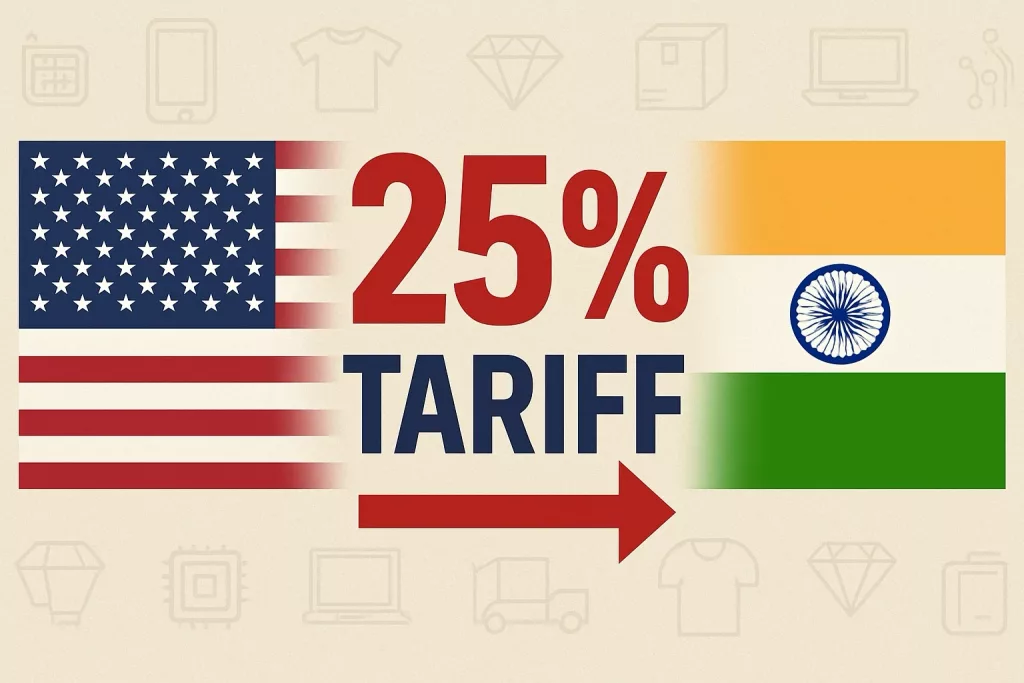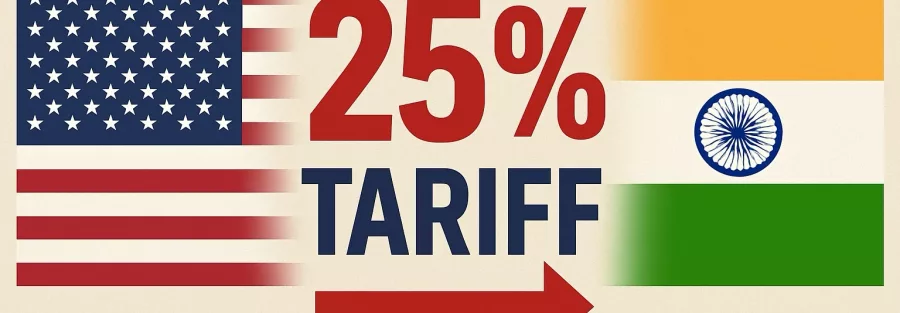
The global trade landscape is witnessing a significant development as the United States unveils a new, stringent trade policy targeting India. In a two-pronged move, the Trump administration has announced a sweeping 25% tariff on all Indian exports to the U.S., coupled with an additional, yet-to-be-defined “penalty” over India’s trade relations with Russia. These measures, slated to take effect on August 1, 2025, are poised to create significant ripples across the Indian economy.
🔍 Let’s Break Down the Potential Consequences
📊 The Big Picture: Economic Projections
The immediate economic shock from the tariffs is expected to be substantial. The U.S. is India’s largest trading partner, with goods exports amounting to approximately $87 billion in 2024. A blanket tariff threatens this vital economic relationship.
- Impact on GDP: Economists are forecasting a notable hit to India’s growth. The 25% tariff could potentially reduce India’s GDP by over 0.5 percentage points, with some estimates placing the economic cost above $30 billion. India’s Finance Secretary has acknowledged that if the tariffs persist, they could trim GDP growth by 0.2 to 0.5 percentage points in the 2026 fiscal year.
- Decline in Export Revenue: By making Indian products more expensive for American consumers and businesses, the tariffs are designed to reduce demand. This directly impacts the revenue and profitability of countless Indian exporters who rely on the U.S. market.
- Pressure on Currency and Inflation: The announcement has already led to a weakening of the Indian Rupee—a logical reaction to the anticipated drop in dollar inflows. A prolonged trade imbalance could further devalue the currency, making imports costlier and potentially stoking inflation.
📦 A Closer Look: Which Sectors Are in the Firing Line?
While the tariff is widespread, its impact will be felt more acutely in certain export-heavy industries. Key sectors expected to bear the brunt of the 25% tariff include:
- 🚗 Automobiles and auto components
- 📱 Electronics, especially smartphones assembled in India
- 💎 Gems and jewelry (with over $9 billion in annual exports to the U.S.)
- 👗 Textiles and apparel
- 🔩 Steel and aluminum
However, the U.S. administration has, for now, exempted a few critical sectors—most notably pharmaceuticals and semiconductors—providing a sliver of relief amidst the broader concerns.
🧩 The “Penalty” Puzzle: An Added Layer of Uncertainty
Adding to the complexity is the undefined “penalty” linked to India’s significant energy and military procurement from Russia. The lack of clarity on what this penalty entails is a major source of economic uncertainty. This ambiguity can be as damaging as the tariff itself, potentially deterring foreign investment and causing market volatility as businesses and investors await more details.
🎯 Negotiating Tactic or a New Reality?
Some analysts speculate that these aggressive tariffs could be a high-stakes negotiating tactic aimed at securing a more favorable trade deal for the U.S. However, the immediate reality for India is a formidable economic challenge. Indian businesses now face the difficult choice of absorbing the additional costs—squeezing their margins—or seeking out alternative global markets to diversify their trade portfolio.
The coming months will be crucial in determining whether this is a temporary storm or the beginning of a more challenging chapter in Indo-U.S. trade relations.
📞 For Guidance on Navigating Market Volatility
Feel free to reach out:
Hitender Tanwar
Authorised Business Partner
Motilal Oswal Financial Services Ltd.
📞 +91 9810685229
📱 WhatsApp: +917683095302
🤖 WhatsApp Chatbot
📧 hitender@gmail.com
📲 Follow Us on Social Media:
📘 Free Ebooks by Hitender Tanwar:
- The Market Crash Playbook
- Investing 101 – A Beginner’s Guide
- Demystifying Commodity Trading in India
📥 Open a Demat Account Now:
Click Here to Open a Demat Account
Member: NSE, BSE, NCDEX, and MCX
BSE Reg. No: AP01044601167550
NSE Reg. No: AP0297590501















































